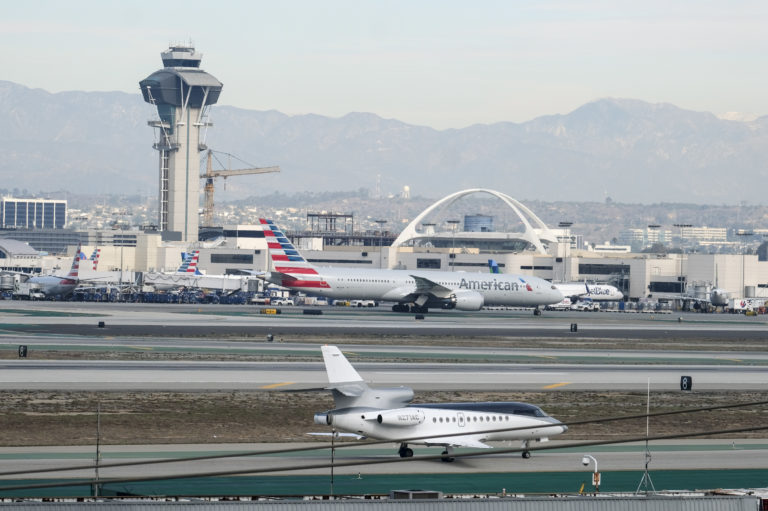
For the first time since the pandemic hit three years ago, domestic passenger traffic in March replaced international traffic as the primary drag on the recovery at Los Angeles International Airport to pre-pandemic levels.
Meanwhile, passenger counts at the other three airports serving Los Angeles County continue to soar past pre-pandemic levels, with the March total for those airports nearly 9% above March of 2019.
LAX, though, continues to lag behind. A total of 5.96 million passengers went through the gates at LAX in March, down 19% from March 2019. The domestic passenger count of 4.28 million was down 19.5% from March 2019, while the international passenger tally of 1.68 million was down 17.8%.
For the past three years since the pandemic shutdown, international traffic has lagged behind domestic travel in terms of catching up to pre-pandemic levels. Indeed, for a stretch three years ago, international travel was down as much as 90%, while concurrent domestic travel was off only about 50%. But after a rapid rebound in international travel over the past year, this changed in March as domestic travel was down more from pre-pandemic levels than international travel.
Even more significant, international passenger counts are continuing to grow much more robustly year-over-year than the domestic passenger traffic (57% vs 3%).
Airport officials attribute this in large part to difficulties the airlines have had in trying to grow domestic flights to match surging demand.
“In speaking with airlines, this is the result of their inability to operate more flights,” said Justin Erbacci, chief executive of Los Angeles World Airports, the city agency that runs LAX. “They are not wanting to build a lot of capacity in the market that they don’t feel they can operate efficiently. So what we’re seeing is that the initial schedules filed months in advance added back a whole bunch of flights, but then some of those flights have been pulled back as the actual travel season approaches.”
Erbacci was referring of course to the persistent levels of flight cancellations last summer and around the holidays, culminating in the near total meltdown of Dallas, Texas-based Southwest Airlines Co. in December. After slashing to the bone as travel plummeted during the early stages of the pandemic, airlines have had great difficulty staffing back up and bringing parked aircraft back into service, among other things.
While nearly all airports have been impacted in some fashion as a result, LAX has taken the biggest hit among the four airports serving Los Angeles County.
“It’s a numbers game,” Erbacci explained. “At the other (regional) airports, it only takes a handful of added flights to make significant progress back to pre-pandemic levels,” he said. “But at LAX, because of its huge size, a whole lot of flights have to be added back, and right now, that’s just not happening as quickly as we would like.”
On the international front, it’s a different story. Thanks to the re-opening of Unites States skies to international travel back in November 2021, many international carriers have been adding back flights – and even introducing new ones – at a rapid clip. Also helping has been an intense push by Los Angeles World Airports and the Los Angeles Tourism and Convention Board to lure back international flights to LAX.
The only major exception has been China, due at first to that country’s “zero-tolerance” Covid policies and, more recently, to rising tensions between China and the United States.
Regional surge
Meanwhile, at Ontario International Airport, it was the busiest March since 2008, as more than 501,000 passengers went through the airport gates. For the entire first quarter, more than 1.3 million passengers went through Ontario, up nearly 17% from the same period a year ago and 12% from the first quarter of 2019.
The growth was more moderate at Hollywood Burbank Airport, with its 494,000 passenger tally representing a 3% increase from last year and a 7.5% increase from 2019.
At Long Beach Airport, the monthly passenger tally has alternatively notched above the same month in 2019 and dipped below that level. In March, the tally of 297,000 happened to be up nearly 9% from a year ago and nearly 3% from March 2019.
Cargo surge over
March provided more evidence that the pandemic-related cargo tonnage surges at local airports has ended. Overall, nearly 284,000 metric tons of cargo were moved at the four airports serving Los Angeles County in March, down nearly 16% from a year ago and up only about 4% from March 2019.
LAX and Ontario make up about 98% of the cargo flowing through the local airports. At LAX, cargo tonnage in March fell more than 17% to 214,000 from March of last year, while Ontario’s cargo tonnage fell more than 10%.
Both airports are still ahead of 2019 cargo tonnage levels, but the gap is shrinking. LAX was only up 3% from 2019, while Ontario was up 9%. A year ago, cargo levels at both airports were running more than 20% ahead of 2019.
